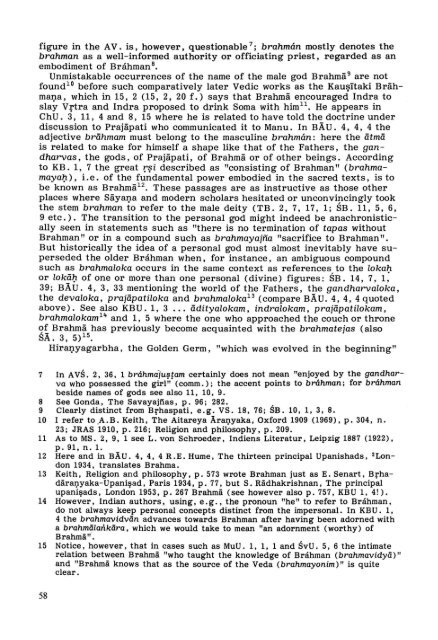Prajapati's relations with Brahman, Brhaspati and Brahma - DWC
Prajapati's relations with Brahman, Brhaspati and Brahma - DWC
Prajapati's relations with Brahman, Brhaspati and Brahma - DWC
You also want an ePaper? Increase the reach of your titles
YUMPU automatically turns print PDFs into web optimized ePapers that Google loves.
figure in the A V. is, ho wever , questionable 7; brahmán mostly denotes the<br />
brahman as a well-informed authority or officiating priest, regarded as an<br />
embodiment of Bráhman 8 •<br />
Unmistakable occurrences of the name of the male god Brahmä 9 are not<br />
found 10 before such comparatively later Vedic works as the Kaufili:taki BrähmaJ}.a,<br />
which in 15, 2 (15, 2, 20 f.) says that Brahmä encouraged Indra to<br />
slay Vrtra <strong>and</strong> Indra proposed to drink Soma <strong>with</strong> him ll • He appears in<br />
ChU. 3, 11, 4 <strong>and</strong> 8, 15 where he is related to have told the doctrine under<br />
discussion to Prajäpati who communicated it to Manu. In BÄ U. 4, 4, 4 the<br />
adjective brähmam must belong to the masculine brahmán: here the ätmä<br />
is related to make for himself a shape like that of the Fathers , the g<strong>and</strong>harvas,<br />
the gods, of Prajapati, of <strong>Brahma</strong> or of other beings. According<br />
to KB. 1, 7 the great f§i described as "consisting of <strong><strong>Brahma</strong>n</strong>" (brahmamayal)),<br />
i. e. of the fundamental power embodied in the sacred texts, is to<br />
be known as Brahmä 12 • These passages are as instructive as those ot her<br />
places where SäyaJ}.a <strong>and</strong> modern scholars hesitated or unconvi!1cingly took<br />
the stem brahman to refer to the male deity (TB. 2, 7, 17, 1; SB. 11, 5, 6,<br />
9 etc. ). The transition to the personal god might indeed be anachronistically<br />
seen in statements such as "there is no termination of tapas <strong>with</strong>out<br />
<strong><strong>Brahma</strong>n</strong>" or in a compound such as brahmayajfia "sacrifice to <strong><strong>Brahma</strong>n</strong>".<br />
But historically the idea of a personal god must almost inevitably have superseded<br />
the older Bráhman when, for instance, an ambiguous compound<br />
such as brahmaloka occurs in the same context as references to the lokah<br />
or lokäl) of one or more than one personal (divine) figures: SB. 14, 7, 1:<br />
39; BÄU. 4, 3, 33 mentioning the world of the Fathers, the g<strong>and</strong>harvaloka,<br />
the devaloka, prajäpatiloka <strong>and</strong> brahmaloka 13 (compare BÄU. 4, 4, 4 quoted<br />
above). See also KBU. 1,3 ... ädityalokam, indralokam, prajäpatilokam,<br />
brahmalokam 14 <strong>and</strong> 1, 5 where the one who approached the couch or throne<br />
of <strong>Brahma</strong> has previously become acquainted <strong>with</strong> the brahmatejas (also<br />
SÄ. 3, 5)15.<br />
HiraJ}.yagarbha, the Golden Germ, "which was evolved in the beginning"<br />
7 In A VS. 2, 36, 1 bráhmalu~tam certainly does not mean "enjoyed by the g<strong>and</strong>harva<br />
who possessed the girl" (comm.); the accent points to bráhman; for bráhman<br />
beside names of gods see also 11, 10, 9.<br />
8 See Gonda, The Savayajfias, p. 96; 282.<br />
9 Clearly distinct from Bfhaspati, e.g. VS. 18, 76; SB. 10, 1,3,8.<br />
10 I refer tO ,A.B. Keith, The Aitareya ÀraI;tyaka, Oxford 1909 (1969), p. 304, n.<br />
23; JRAS 1910, p. 216; Religion <strong>and</strong> philosophy, p. 209.<br />
11 As to MS. 2, 9, 1 see L. von Schroeder, Indiens Literatur, Leipzig 1887 (1922),<br />
p. 91, n. 1.<br />
12 Here <strong>and</strong> in BÀU. 4, 4, 4 R.E. Hume, The thirteen principal Upanishads, 2London<br />
1934, translates <strong>Brahma</strong>.<br />
13 Keith, Religion <strong>and</strong> philosophy, p. 573 wrote <strong><strong>Brahma</strong>n</strong> just as E. Senart, BrhadaraI;tyaka-Upanililad,<br />
Paris 1934, p. 77, but S. Radhakrishnan, The principal<br />
upanililads, London 1953, p. 267 <strong>Brahma</strong> (see however also p. 757, KB U 1, 4!).<br />
14 However, Indian authors, using, e.g., the pronoun "he" to refer to Bráhman,<br />
do not always keep personal concepts distinct from the impersonal. In KBU, 1,<br />
4 the brahmavidvän advances towards <strong><strong>Brahma</strong>n</strong> after having been adorned <strong>with</strong><br />
a brahmälankära, which we would take to mean "an adornment (worthy) of<br />
<strong>Brahma</strong>"'.<br />
15 Notice, however, that in cases such as MuU. 1, 1, 1 <strong>and</strong> SvU. 5, 6 the intimate<br />
relation between <strong>Brahma</strong> "who taught the knowledge of Bráhman (brahmavidyä)"<br />
<strong>and</strong> "<strong>Brahma</strong> knows that as the source of the Veda (brahmayonim)" is quite<br />
clear.<br />
58
















